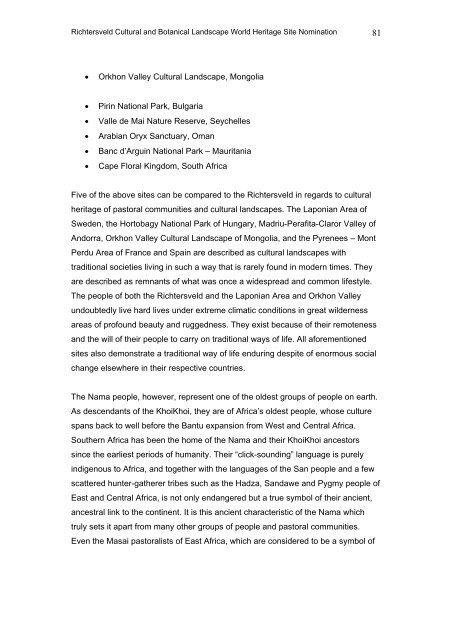the richtersveld cultural and botanical landscape - SAHRA
the richtersveld cultural and botanical landscape - SAHRA
the richtersveld cultural and botanical landscape - SAHRA
You also want an ePaper? Increase the reach of your titles
YUMPU automatically turns print PDFs into web optimized ePapers that Google loves.
Richtersveld Cultural <strong>and</strong> Botanical L<strong>and</strong>scape World Heritage Site Nomination 81<br />
• Orkhon Valley Cultural L<strong>and</strong>scape, Mongolia<br />
• Pirin National Park, Bulgaria<br />
• Valle de Mai Nature Reserve, Seychelles<br />
• Arabian Oryx Sanctuary, Oman<br />
• Banc d’Arguin National Park – Mauritania<br />
• Cape Floral Kingdom, South Africa<br />
Five of <strong>the</strong> above sites can be compared to <strong>the</strong> Richtersveld in regards to <strong>cultural</strong><br />
heritage of pastoral communities <strong>and</strong> <strong>cultural</strong> l<strong>and</strong>scapes. The Laponian Area of<br />
Sweden, <strong>the</strong> Hortobagy National Park of Hungary, Madriu-Perafita-Claror Valley of<br />
Andorra, Orkhon Valley Cultural L<strong>and</strong>scape of Mongolia, <strong>and</strong> <strong>the</strong> Pyrenees – Mont<br />
Perdu Area of France <strong>and</strong> Spain are described as <strong>cultural</strong> l<strong>and</strong>scapes with<br />
traditional societies living in such a way that is rarely found in modern times. They<br />
are described as remnants of what was once a widespread <strong>and</strong> common lifestyle.<br />
The people of both <strong>the</strong> Richtersveld <strong>and</strong> <strong>the</strong> Laponian Area <strong>and</strong> Orkhon Valley<br />
undoubtedly live hard lives under extreme climatic conditions in great wilderness<br />
areas of profound beauty <strong>and</strong> ruggedness. They exist because of <strong>the</strong>ir remoteness<br />
<strong>and</strong> <strong>the</strong> will of <strong>the</strong>ir people to carry on traditional ways of life. All aforementioned<br />
sites also demonstrate a traditional way of life enduring despite of enormous social<br />
change elsewhere in <strong>the</strong>ir respective countries.<br />
The Nama people, however, represent one of <strong>the</strong> oldest groups of people on earth.<br />
As descendants of <strong>the</strong> KhoiKhoi, <strong>the</strong>y are of Africa’s oldest people, whose culture<br />
spans back to well before <strong>the</strong> Bantu expansion from West <strong>and</strong> Central Africa.<br />
Sou<strong>the</strong>rn Africa has been <strong>the</strong> home of <strong>the</strong> Nama <strong>and</strong> <strong>the</strong>ir KhoiKhoi ancestors<br />
since <strong>the</strong> earliest periods of humanity. Their “click-sounding” language is purely<br />
indigenous to Africa, <strong>and</strong> toge<strong>the</strong>r with <strong>the</strong> languages of <strong>the</strong> San people <strong>and</strong> a few<br />
scattered hunter-ga<strong>the</strong>rer tribes such as <strong>the</strong> Hadza, S<strong>and</strong>awe <strong>and</strong> Pygmy people of<br />
East <strong>and</strong> Central Africa, is not only endangered but a true symbol of <strong>the</strong>ir ancient,<br />
ancestral link to <strong>the</strong> continent. It is this ancient characteristic of <strong>the</strong> Nama which<br />
truly sets it apart from many o<strong>the</strong>r groups of people <strong>and</strong> pastoral communities.<br />
Even <strong>the</strong> Masai pastoralists of East Africa, which are considered to be a symbol of

















